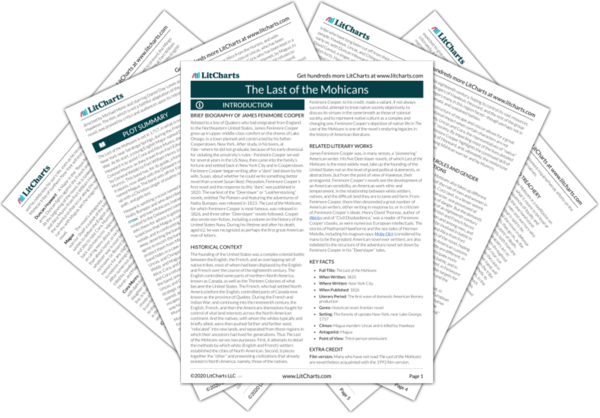The Last of the Mohicans also takes up different understandings of the role of men and women in European and native societies. Cora (and, to a lesser extent, Alice) is a three-dimensional character, one possessed of courage and ingenuity in the face of danger. But the demands placed on her life are those typical of an eighteenth-century woman. Generally speaking, both British and French forces believe that war is to be fought by men and among men, and that “women and children” should not be involved in battle in any way. Thus Heyward conveys Cora and Alice from Fort Edward to Fort William Henry at the start of the novel, hoping to keep them out of harm’s way. But Native American customs regarding the involvement of women in battle are different, in two ways: first, women in native cultures participate more openly and centrally in the rituals that precede battle, and in preparations for warriors; and women are treated, in Fenimore Cooper’s rendering of native custom, as reasonable targets for battle, especially as regards the capture of women and the holding of them for ransom.
Thus Magua demands at several times in the novel that, in order to save her sister and family, Cora abandon her European heritage (which is in fact biracial, as Cora’s ancestor is a native of the West Indies) and become his wife. To the British, the notion of Cora marrying a native is abhorrent and “unnatural,” and to Magua, the capture of Cora is an important sign of victory in battle—Cora is, therefore, his “prize.”
There is also a broader distinction made between “male” and “female” conduct. Both native and European societies have particular conceptions of acceptable male and female behavior. In particular, in native society, among the Mingos and the Delawares, it is considered a high insult for a warrior to be compared to a woman. This might happen for any of a number of reasons, but would include leaving a battle before killing all one’s enemies, or the showing of mercy. On the other hand, European society obeys a chivalric set of principles regarding male-female relations: in other words, male soldiers are expected to give everything, even their lives, to protect women. Ultimately, it is the “horrific” idea of Magua capturing and marrying Cora that provokes Hawkeye and the rest of the group to follow Magua and kill him. At this climactic point of the novel, Cora officially states she would rather die than marry Magua, and though Magua hesitates in killing Cora, a confederate of his does. Cora therefore maintains her “purity,” and Magua shows that, for him, Cora is the ultimate token of greatness—a wife “taken” from her European society and forcibly removed to native society.
Gender Roles and Gender Expectations ThemeTracker

Gender Roles and Gender Expectations Quotes in The Last of the Mohicans
Yes, the pale-faces are prattling women! They have two words for each thing, while a redskin will make the sound of his voice speak for him.
And am I answerable that thoughtless and unprincipled men exist, whose shades of countenance may resemble mine?
Hold! ‘Tis she! God has restored me to my children! Throw open the sally-port; to the field; . . . pull not a trigger, lest ye kill my lambs!
Ah! thou truant! thou recreant knight! He who abandons his damsels in the very lists! Here we have been days, nay, ages, expecting you at our feet, imploring mercy and forgetfulness of your craven backsliding . . . .
You know that Alice means our thanks and our blessings . . . .
Heyward, give me the sacred presence and the holy sanction of that parent [Munro] before you urge me further.
The pale-faces are dogs! The Delawares women! Magua leaves them on the rocks, for the crows!











